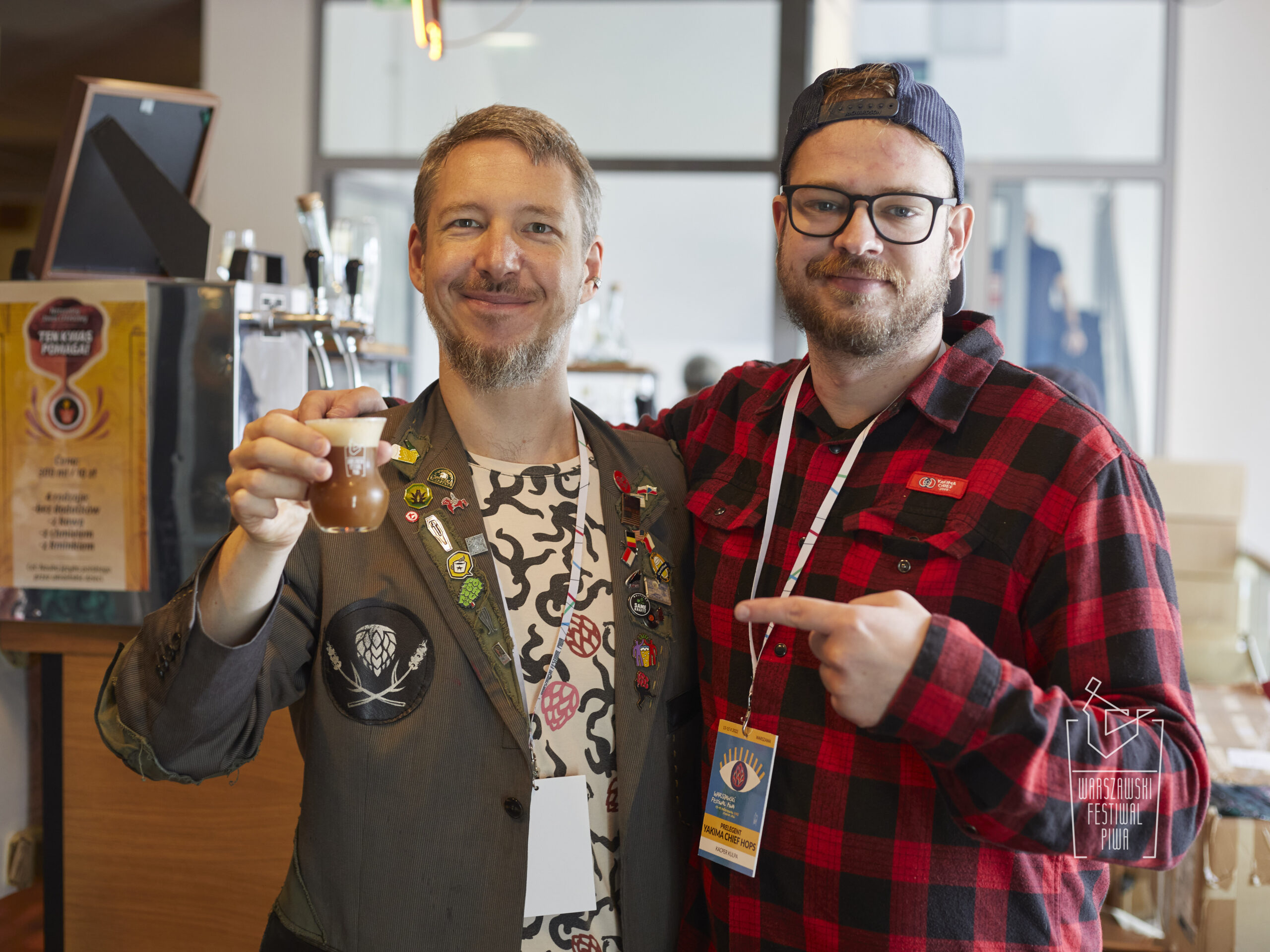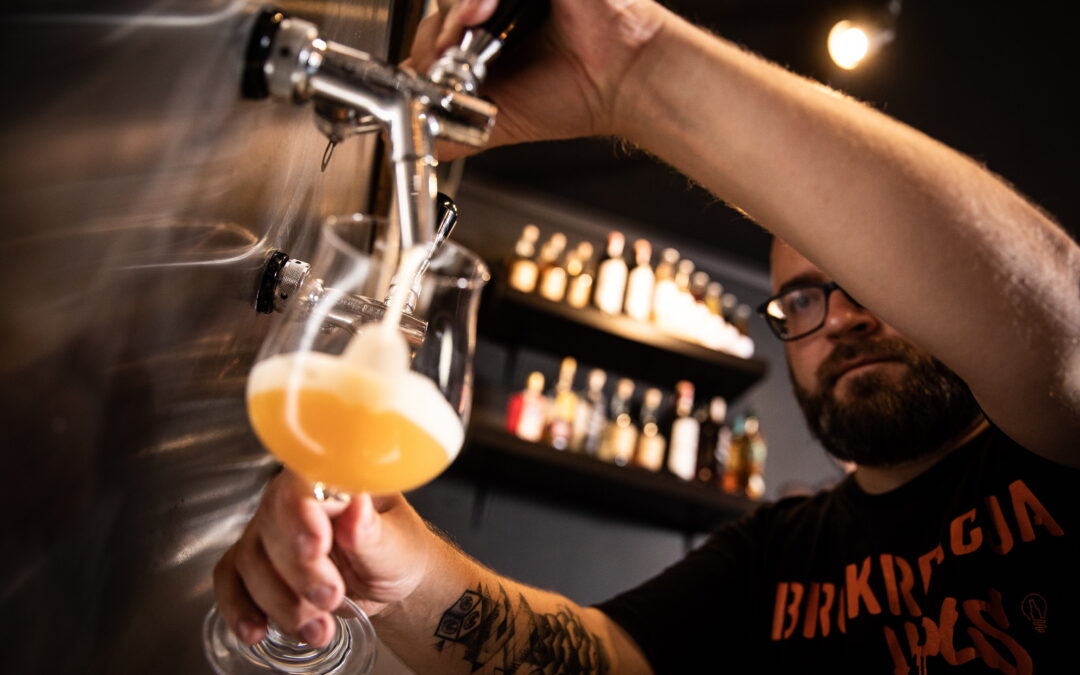By Alex Webber
Celebrating its tenth anniversary this weekend, the Warsaw Beer Festival has emerged from modest beginnings to become a calling card for Poland’s craft brewing scene, which has caused ripples across Europe for the extent of its ambition and experimentation.
“Polish brewing has gone from zero to hero,” says Paweł Leszczyński, the founder of the festival (pictured below left). “The diversity, variety and authenticity of Poland’s craft sector is unique.”

More than just hyperbole, Leszczyński’s words reflect not just the enthusiasm with which Polish craft has been met, but also the meteoric advances that have been made by a sector that had to build from scratch.
Left decimated by decades of communist rule, what remained of Poland’s brewing culture found itself all but wiped out in the 1990s following the corporate buyouts that marked the early days of the free-market transition.
However, the death of small-scale brewing would ultimately benefit Poland in the long run. “It allowed our breweries to start with a blank slate using their own set of rules,” says Leszczyński. Even so, what happened next can be considered something of a miracle.
“When Poland’s first homebrewers were beginning to experiment, I don’t think anyone dreamed that it would be possible to open their own brewery,” says Leszczyński.
The 2011 tapping of Atak Chmielu, an American-style IPA brewed by Pinta, opened the floodgates to this core of hobby brewers, and in the process sparked what is now known as the “piwo-lution” (the Polish word for beer is piwo).
Pinta collection #beer #IPA pic.twitter.com/uGOTmUWmIa
— Man On The Silver Mountain (@manonthesilver) January 19, 2023
Steep as the learning curve was, Polish brewers soon proved adept at latching on to global trends whilst simultaneously adding their own innovative spin.
“At the start, those outside Poland weren’t interested in our market,” says Leszczyński. “As such, we had to create our own judging program. It was much more detailed and much more complex than that seen in many countries; our small association of homebrewers became super active in creating competitions and teaching people how beer should taste. Quality soared.”
Such has been the speed with which Poland has embraced craft beer that in 2018 Steve Dresler (the beer guru who helped transform Sierra Nevada into one of the world’s top craft breweries) asserted that it would not be long before American brewers would be looking to Poland for inspiration.
When, in 2019, CNN named Warsaw as having one of the top craft bar scenes in the world, the spotlight became all the stronger. This has not subsided. Across Europe, historical brewing powerhouses have looked on with envy.
#FoodieFriday: Warsaw makes @CNN's list of 15 best beer cities around the world! Cheers! 🍻
👉 https://t.co/ADKbaeccJo@PLenMexico @PLinstStockholm @TydzienPolski @travel2poland @PLinAustralia @PolandTravel_UK pic.twitter.com/wUAbhtHM85
— Culture.pl (@culture_pl) August 16, 2019
“Polish craft has become popular in countries where traditional beer still dominates,” says Michał Maranda, one of Poland’s best-known beer judges. “For example, in the Czech Republic, it’s easier to find a new wave Polish beer than it is a new wave Czech one. Additionally, the slightly lower price has made Polish crafts popular abroad.”
According to the latest available figures, in 2020 around 40% of Polish craft breweries reported being “active” on foreign markets, with an average of 10% of their production going for export.
In the first quarter of 2022, the 326 hectolitres exported by Pinta, Poland’s original craft brewery, was more than their figure for the entire first half of 2021.
“The Germans, Czechs, Slovaks and Belgians all have an incredibly strong beer heritage, yet they’re looking at Poland now,” says Leszczyński . “Sure, they have some experimental breweries, but they’re in awe of the number of craft breweries we have and the quality coming from these.”
🍻🍺 In 2022, EU countries produced almost 34.3 billion (bn) litres of beer.
Top beer producers:
🇩🇪 Germany (7.6 bn litres; 22.2% of the total EU production)
🇪🇸 Spain (3.9 bn litres; 11.5%)
🇵🇱 Poland (3.7 bn litres; 11.0%)👉 https://t.co/QxtcaYfT4D#InternationalBeerDay pic.twitter.com/bQz9JMLpK4
— EU_Eurostat (@EU_Eurostat) August 3, 2023
Price, of course, has played a role. “If you’re being paid in euros, then Poland remains a good deal,” says Leszczyński. “Craft beer is a premium product, so if you can buy a pint for two euros less then you’ll automatically pay attention.”
“However, it’s also our diversity that has been crucial,” he adds. “We’ve got around 400 craft breweries producing around 2,500 new beers each year – at the beer festival alone, you’ll be able to try between 1,300 and 1,400 different beers.”
Unique to Poland is Grodziskie, a beer that Maranda describes as being “light, sparkling and refreshing”, complete with “a hint of wood-smoked oak wheat malt.”
Grodziskie
📍 Grodzisk Wielkopolski, Poland 🇵🇱
⭐ 4.5
💯 #1 best-rated beer style in the worldhttps://t.co/e9nrLQiZCdGrodziskie (Grätzer) is a historical beer style from Poland that was originally produced by brewers in the town of Grodzisk. When it was under Prussian rule,… pic.twitter.com/ktFA2jJlBv
— TasteAtlas (@TasteAtlas) May 5, 2023
Maranda also highlights the quality of the Baltic Porters – though not unique to Poland – being produced by the country’s breweries. “Moreover,” he adds, “our Hazy IPAs have now reached a very high level.”
Showing a readiness to get inventive, the nation’s alternative breweries have also helped put Poland on the map. Founded in 2018, Funky Fluid is one such example.
“Of course we follow trends, but we also look to set them as well,” says Grzegorz Korcz, the brand’s creative director and head of export. In this regard, the brewery’s range of ice cream-inspired “Gelato” beers have played a prominent part.
“That’s been a really important series for us and it opened the door for the other beers in our portfolio as well,” says Korcz. “But although we are known for our modern beers, we also like to experiment with classical styles, such as wild beers or barrel-aged beers.”
With 30% of Funky Fluid’s production line now going for export, the brand has become something of a poster child for Polish craft.
“We try to be very visible at festivals, and not just in Poland,” says Korcz. “That’s really helped us, but I think in general we now see that Poland has earned a very positive reputation abroad.
“We’ve got into people’s minds and we’ve demonstrated that the country is an interesting beer destination,” he adds. “It’s not an exaggeration to say we’ve got one of the most exciting scenes in Europe.”
Winegrowing, once widespread in Poland, is again part of the landscape after dying out amid a cooling climate and political upheaval.
Inka Wrońska of @fermentmag offers a guide to the growing industry and recommendations for the best vineyards and wineshttps://t.co/B2B75cncMH
— Notes from Poland 🇵🇱 (@notesfrompoland) November 19, 2021
This view is echoed by Leszczyński. “Our breweries are trying a lot of new things and are reaching other countries. Many craft breweries around Europe aren’t all that concerned about pushing their export side, but in Poland there are many and that’s helped get us noticed.”
The focus on exports has also been necessitated by tougher economic conditions at home in recent years, with the impact of the pandemic then followed by the effects of the war in neighbouring Ukraine. Production costs rose 25% in 2022 alone, while prices went up 12%.
“We’re having to work a lot harder,” says Korcz. “We can no longer just sell to bars and craft stores, we have to look at different solutions and markets, whether that be increasing our exports or distributing to supermarket chains. To grow, you need to be flexible.”
“These are undoubtedly the hardest times for Polish brewers since the revolution began, and we’ve seen that price really does matter,” says Maranda.
One of Poland’s largest brewers, Żywiec, is collecting beer that has gone unsold during the pandemic and is using it to produce biogas to power its breweries https://t.co/F1zHnlBWph
— Notes from Poland 🇵🇱 (@notesfrompoland) June 8, 2021
The craft breweries, however, are fighting back and, although casualties have been recorded, the mass closures that were feared at the beginning of the pandemic have not come to fruition.
Product diversification and the development of distribution channels have been key and, despite declining sales in 2023, industry experts forecast growth for this year and the next.
Maranda remains confident that craft beer’s unique selling point and driving force – the passionate individuals who produce it – will see the sector through the crisis.
“Craft is, above all, about people. The beer is important, but we should always pay heed to those that are behind it – they are the very essence that distinguishes it from the mass market.”

Notes from Poland is run by a small editorial team and published by an independent, non-profit foundation that is funded through donations from our readers. We cannot do what we do without your support.
Main image credit: Jakub Wlodek / Agencja Wyborcza.pl




















